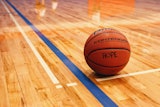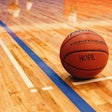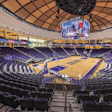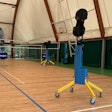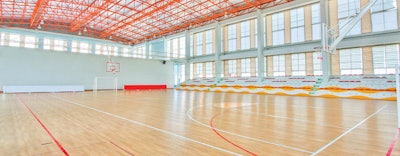
A hardwood court is a big investment for any athletic facility. Like any big investment, organizations want to do whatever they can to take care of it. But when the people in charge of the court are unfamiliar with proper basic care, they tend to end up doing too much — or not enough. "With gym floors, there's so many misconceptions about what you're supposed to or not supposed to do because the floor is wood," says Bill Price Jr., national sport manger with Aurora, Colo.-based hardwood care specialist Bona. "The people who maintain floors have grown up with the notion that you can't put water on wood. For that reason, most gym floors get neglected. They don't get the proper maintenance because people are afraid."
A minimum of a once-daily dry mopping and tacking is recommended, but what does that mean? Moreover, do the people taking care of the floors understand why they're doing what they're doing?
THE NITTY GRITTY
Gerry Harris, founder and president of Orange, Calif.-based Court Clean, recommends a daily cleaning first thing in the morning. "The dust and dirt have settled on the floor overnight," he explains. "The dirt is acting like sandpaper — the first person who walks on your floor every morning is basically scratching it."
This cleaning should be done regardless of how often a floor is used, Harris adds. "It's a matter of the dirt and dust that are in the air. You can go in a gym that hasn't been used at all and still clean it three times a day, and it'll be filthy."

Especially in older buildings or those with poorly maintained HVAC systems, dust can become a real issue. "If I had to throw a made-up number at you, I would say 90 percent of the issues related to slip are caused by dust on the surface," says Price. "You go into a gym and look up near the rafters, lighting, and fans and you can see dust caked on — that's usually an indicator that there's a lot of dust in the facility, and you have to do your best to try and stay ahead of it."
Though reducing the amount of dust in a facility may be hard to do, facilities can take steps to reduce the amount of dirt and debris tracked into the gym by users and spectators. Asking gym users not to wear street shoes onto the court is a start but hard to enforce. That is why most floor-care experts recommend walk-off mats.
"Walk-off mats are one of the most important things that a gym can provide to restrict some of that grit from making it into the gym," says Price. Without proper care themselves, however, walk-off mats will do nothing but create a built-up supply of debris for users to track in. "Just because you have them doesn't mean they're free and clear. They have to be vacuumed and maintained on a daily basis."
Mats should be located at facility entranceways as well as entrances to the gym, creating as many opportunities as possible to trap dirt before it gets anywhere near the hardwood. "The best thing that can be done for a gym floor is keep it free of grit," says Price. "It's the major obstacle for any gym floor. If they can keep the grit off, that will save so many headaches and so much future wear."
CHEMICAL BALANCE
A daily dry mopping or sweeping will minimize loose grit and dirt, but removal of caked-on debris or dried-on residue requires a little more effort. "Lightly saturate a towel or a microfiber cloth and push it around the floor to get the dirt off the floor," says Brent Sorbet, technical services coordinator at Dollar Bay, Mich.-based Horner Flooring, referring to the practice of tacking. "That's the poor man's way of cleaning a floor, and that's how floors were cleaned for years before they came out with all of these devices."
There are a variety of cleaning tools available to make the process go faster and more efficiently, but if whoever is cleaning the court doesn't understand what they're doing, they can end up causing significant damage to a floor. The staples of janitorial closets — the mop and bucket — aren't typically recommended for use on hardwood floors. Not only is it more time-consuming than other options, but over-mopping can cause water damage to floors. "I've seen people let floors soak when they feel the floor is excessively dirty," says Sorbet. "That's a no-no. The moisture and water get down in the cracks and can ruin the floor. It changes the whole moisture content and causes bigger issues."
Mopping also presents the risk of another common court-cleaning mistake: cross-contamination. "Someone will mop a hallway and then use that same mop in the gym," says Price, which will more often than not leave the floor looking cloudy and unclean because of residue left behind. Using dirty water to try to clean a floor is in itself a poor decision, but the chemicals used to clean a school hallway also are not the same ones recommended to clean hardwood.
"The wrong cleaning product may make a floor slick, hazy or sticky," says Sorbet, who recommends having a dedicated set of cleaning tools and supplies for the court. While a shiny floor is aesthetically pleasing, the real issue is how a chemical affects the surface tension. "You don't want it so tight that you could twist something nor create a slip hazard."
So what should be used to clean the floor? "All the different finish companies have their own cleaners," says Harris. "But basically, any floor cleaner will work on a floor; it's not dependent on the type of finish. Any neutral-pH floor cleaner will work. Even water will do."
A well-maintained floor shouldn't need an arsenal of chemicals that claim to restore shine or prevent slip, nor does a court need to smell citrusy-fresh. To avoid over-saturating, a floor cleaner should be applied either with a towel or cleaning system such as Court Clean's, which involves an apparatus pulled along the floor, allowing for full-court coverage in a few minutes.
The most controversial cleaning tool in the industry is the automatic floor scrubber. "A lot of manufacturers — the Maple Flooring Manufacturers Association included — don't see eye to eye on the use of scrubbers," says Price. "We say they can use it, with conditions: It has to be very well-maintained, have a good vacuum, function properly. We look at it from the standpoint of the finish. It's not going to hurt the finish, but it may do something to the wood if it's not working properly."
The devices, when used correctly, can shave significant time off the cleaning process, and are commonly seen in larger facilities. "Marquette University has a 25,000-square-foot court," says Sorbet, whose official stance is against using floor scrubbers. "Do you think they tack that every day? They use floor scrubbers. There isn't one facility that has more than a 15,000- to 30,000-square-foot gym doing it by hand. But it is not MFMA-approved."
Like a mop-and-bucket system, the concern is that improper application will damage the floor. If it's not working properly, operators run the risk of over-saturating an area of the floor or doing damage with scrubbing pads. For smaller facilities, the time-savings of a scrubber usually isn't worth the potential risk. For trouble spots, the old way is still the most reliable, says Sorbet. "I would just go in with a spray bottle or can of mineral spirits, walk a floor, scrape debris off or give it a spray to take film off."
A CLEANER COAT
Proper daily maintenance isn't just about keeping the court safe for daily use, but also over the long term. "The longer a floor goes without maintenance, the more difficult it becomes to get that floor back into good shape when it comes time for a recoat," says Price. "If it's not well-maintained or there's a lot of scuffs, and if they can't get all of the imperfections off before they put on the next coat, then they're just trapping them in. The floor will never really look fresh and clean."
Most manufacturers recommend recoating a hardwood court on a yearly basis, though budgets might not allow for it. For facilities that don't do a yearly recoating, it's even more important to keep up with the daily cleaning. "The main thing removing the finish on the floor is dirt," says Harris. "By keeping it clean, you're preserving the finish, which thereby equates to dollars."
While proper care can delay how long a floor can go between coatings, it is not a replacement. Regular recoating is a necessary investment, and, like proper daily care, staves off more expensive work. "Usually the most inexpensive thing that can be done on a floor is the recoat," says Price. "If a facility doesn't maintain the floor and it looks rough after eight years, the re-sand is going to be four to five times as expensive to get it in good shape again."
Facility owners should also understand that a proper care regimen keeps a floor safe for use and looking good, but scuffs and scratches on a floor are inevitable. "We do a lot of work with the NBA and NCAA," says Price. "Those floors are some of the most high-profile floors in the world. They're also pampered to the point where not too many activities actually take place on them. They're usually put down for a game, and then they pick them up and put them away. There's so much more that happens to a school floor in terms of abuse and so much more maintenance that would be required to keep it up."
This article originally appeared in the May 2014 issue of Athletic Business under the headline, "Squeaky Clean."














